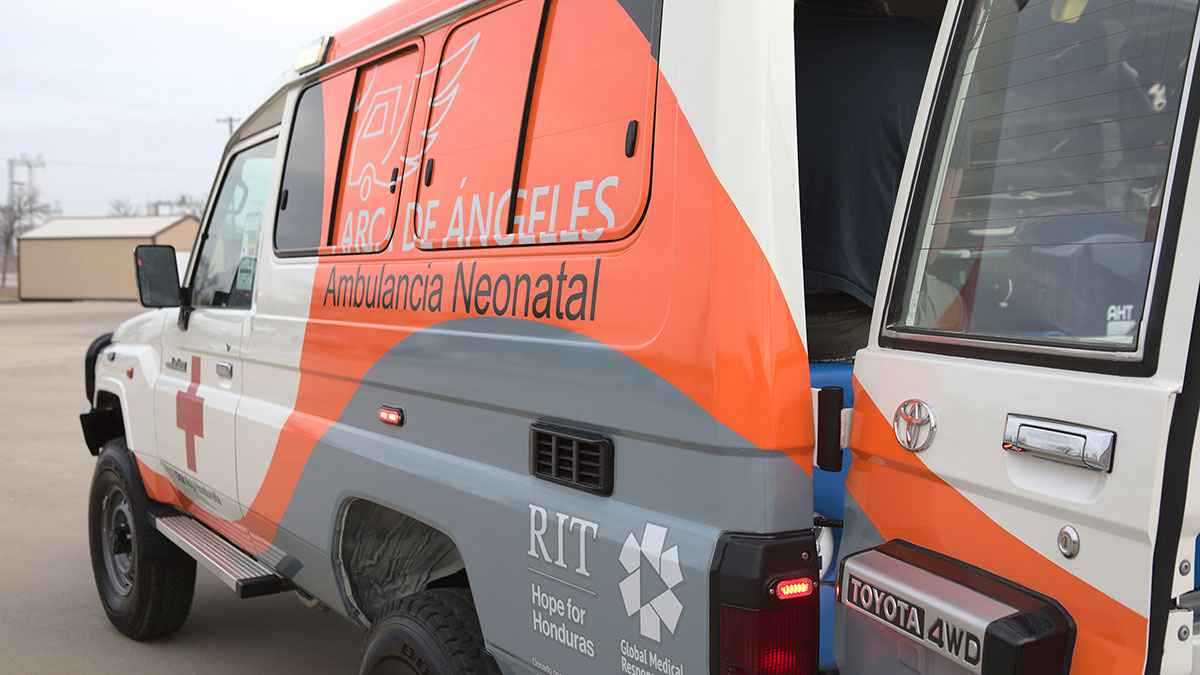Product and Service Design
Hope for Honduras
RIT Hope for Honduras is an initiative creating awareness and innovative design solutions to improve the quality of medical care and education in the Central American country. Started by Mary Golden, undergraduate program director of Interior Design, it consists of a multidisciplinary contingent of RIT faculty, students and alumni in collaboration with in-country partner Hospital Escuela, Honduras’ largest public hospital, non-profit organization Little Angels of Honduras (LAH) and several corporate partners.
Faculty and students from majors such as Interior, Industrial and Graphic Design, as well as the Electrical, Mechanical and Biomedical Engineering, have worked together to develop solutions that offer better access to medical care in Honduras.
The project includes designs of preemie wraps that facilitate skin-to-skin incubation care and transforming a Toyota Land Cruiser into a state-of-the-art neonatal transport ambulance that will provide life-saving transit for critically-ill newborns. Upon completion of the build out, the vehicle will be donated to the Honduran Red Cross (HRC) for service in the capital city of Tegucigalpa.
Corporate collaborators in the realization of project prototypes include American Medical Response (AMR), Autodesk and Herman Miller.

Industry Exposure
RIT's Metaproject course pairs industrial design students with an industry partner to solve a design problem. For one of the projects (pictured), 13 students worked with high-end, alumni-owned furniture brand Lazzoni to each produce a seating solution that were manufactured into full-scale prototypes by Lazzoni.
One of the designs, "Shell Chair" by Dylan Malone '23, was selected by the real-world client as the class' winning design. Lazzoni plans to work with him to move the chair into production and make it commercially available at Lazzoni stores in the future. There are a handful of industrial design alumni who had their Metaproject designs hit the marketplace.
“To see the end result is really beyond our expectation and imagination,” said Efe Kababulut ’09 (industrial design), creative director and board member of Lazzoni Furniture and Lazzoni Hotel who led the company’s Metaproject involvement. “We thought the winner would be obvious and straightforward, but it was hard to pick and choose which was the best. They all had amazing contributions and amazing work.”
Mobile Kitchen
Interior and Industrial Design students developed a mobile kitchen called MO:KI, a bespoke collection of modular units that highlight work zones for cooking, cleaning and preparation. The versatile system affords users the ability to organize an environment that best fits their specific needs. It was exhibited at the International Contemporary Furniture Fair as part of New York City Design Week.
Wayfinding Design

Jordana Deutsch ’19 (Industrial Design) and Matthew Hough ’19 (Graphic Design) worked with the Ganondagan State Historic Site to develop a site-specific wayfinding system respecting Haudenosaunee culture and aesthetics. Their design welcomes visitors to the site and guides them through 569 acres of trails.
The concept was developed during T-Minus, the Industrial Design’s annual design workshop tasking teams of students with completing a sponsored project that solves a real-world problem for a client. In this case, the Ganondagan State Historic Site chose to move forward and make one of the T-Minus proposals a reality.
Deutsch and Hough worked together to design a welcome sign and more user-friendly site map.
“The map that the museum had before we started this project was really hard to understand and wasn’t very clear to readers,” Deutsch said. “We simplified the map so anyone could read it, see where they are and figure out where they need to go throughout the site.
“For the welcome sign, the original one had wrong information on it and was generally unclear for visitors. I revamped the overall design and included iconic elements from the historic site, such as the Ganondagan Man. Design elements on the welcome sign were also used in the map to make the pieces more cohesive.”

















